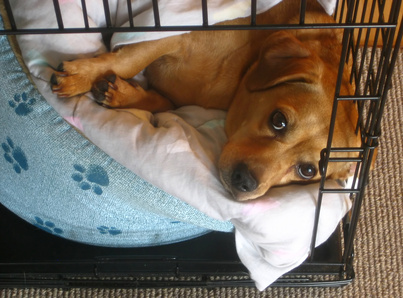Dog Crate - A Training To Your Labrador Dogs
A dog crate can be a very useful tool when you are looking to train your dog.
Labrador retrievers are usually easy to train and, though it may take a couple of weeks, seeing your pet obedient to your commands is truly worth the wait.
It is best to train your Lab when they are still young.
Dogs in nature are den dwelling animals, hence teaching them to stay inside a dog crate is not hard to do as it is a dogs instinct to go into a den for safety and comfort.

There are also other benefits to both the dogs and their owners as dog crates limit their access to the home especially if they are not yet well-trained with the house rules.
At the same time, owners will find it easier to keep their homes tidy especially when the Labs encounter behavioural problems.
Picking The Ideal Crate
Dog crates come in different kinds and sizes. Be sure to find the perfect size for your Lab to keep them comfortable and safe. They must be able to move, lie down, and turn around freely though it must not be over-large as the dog will not feel as secure if there is too much space around him.
Types include materials such as wire or plastic. Wire dog crates allow you to see your Lab easily and cleaning them is not hard. They can be folded so they are easy to store and carry.
Aside from that, they provide good ventilation and have divider panels that you can adjust as your pet grows.
Plastic crates have fewer openings that allow your Lab more time alone to enjoy in their comfort zone. They provide proper insulation, which is best for cold seasons. They are lightweight and are ideal to carry when traveling.
The Crate Training Process For Your Labrador
* Acquaint your Lab to the new crate. Be certain not to compel them to go inside if they don't want to. You can place food near the crate to attract their attention.
* Let them have their meal inside the crate. This will make them feel comfortable and give them a good association with the crate. If you think they are already well adjusted to get in and out from it whenever they eat, you can try closing the door when they take their meal.
* Place your Lab inside the crate for longer and longer periods until they get used to it. It would be great if you gave them some treats every time they follow your commands. Give them more rewards and praise every time they obey your orders.
* If your dogs usually sleep in the same room as you place the crate near your bed and try to make them sleep inside it. Eventually, they will feel comfortable and secure every time they stay in it.

Training Rules
Do not rush your Lab in introducing them to their crate. Give them ample time to adjust, until they finally feel comfortable with it. Give them rewards and praises each time they make some progress.
If you think your pet is uneasy or is experiencing separation anxiety, never place them inside. This may be harmful and may injure them if they try to find ways to escape. Keeping your Lab inside must not be used as a punishment.
Crates for your dogs are supposed to make them feel safe. Therefore, always make them feel that placing them inside the crate gives them protection and security.
Related Articles
Choosing A Dog Crate
Your Labrador Retriever At Home
Your Dog And Seperation Anxiety
Training Your Dog